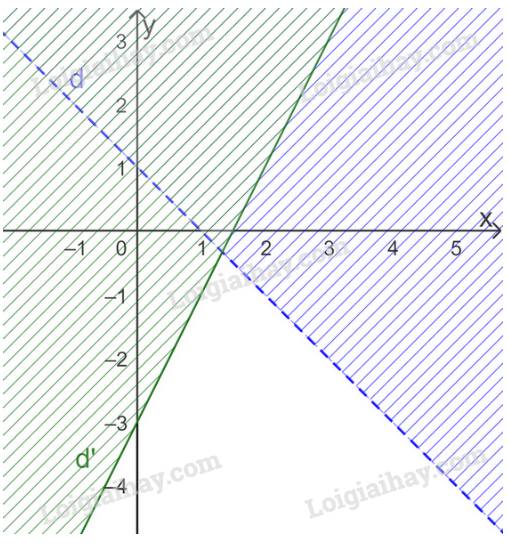1) Giải hệ phương trình $\left\{\begin{array}{l}2 \sqrt{x}+\dfrac{3}{y-1}=5 \\ 4 \sqrt{x}-\dfrac{1}{y-1}=3\end{array}\right.$
2) Trong mặt phẳng tọa độ $Oxy$, cho parabol $(P): y=x^{2}$ và đường thẳng $(d): y=m x-1$, với $m$ là tham số ($m \neq 0$)
a) Khi $m=3$, tìm tọa độ giao điểm của đường thẳng $(d)$ và parabol $(P)$.
b) Tìm tất cả các giá trị khác 0 của tham số $m$ để đường thẳng $(d)$ cắt parabol $(P)$ tại hai điểm phân biệt có hoành độ $x_{1} , x_{2}$ thỏa mãn $x_{2}(x_{1}^{2}+1)=3$.


1) ĐK \(\hept{\begin{cases}x\ge0\\y\ne1\end{cases}}\)
Đặt \(\hept{\begin{cases}2\sqrt{x}=a\left(a\ge0\right)\\\frac{1}{y-1}=b\left(b\ne0\right)\end{cases}}\)hệ phương trình đã cho trở thành
\(\hept{\begin{cases}a+3b=5\\2a-b=3\end{cases}}\Leftrightarrow\hept{\begin{cases}2a+6b=10\\2a-b=3\end{cases}}\Leftrightarrow\hept{\begin{cases}7b=7\\2a-b=3\end{cases}}\Leftrightarrow\hept{\begin{cases}a=2\\b=1\end{cases}\left(tm\right)}\)
\(\Rightarrow\hept{\begin{cases}2\sqrt{x}=2\\\frac{1}{y-1}=1\end{cases}}\Rightarrow\hept{\begin{cases}x=1\\y=2\end{cases}}\left(tm\right)\)
Vậy ...
1,\(\left\{{}\begin{matrix}2\sqrt{x}+\dfrac{3}{y-1}=5\\4\sqrt{x}-\dfrac{1}{y-1}=3\end{matrix}\right.\) ĐKXĐ:x≥o,y≠1
⇔\(\left\{{}\begin{matrix}4\sqrt{x}+\dfrac{6}{y-1}=10\\4\sqrt{x}-\dfrac{1}{y-1}=3\end{matrix}\right.\Leftrightarrow\left\{{}\begin{matrix}\dfrac{7}{y-1}=7\\4\sqrt{x}-\dfrac{1}{y-1}=3\end{matrix}\right.\)\(\Leftrightarrow\left\{{}\begin{matrix}y-1=1\\4\sqrt{x}-\dfrac{1}{y-1}=3\end{matrix}\right.\Leftrightarrow\left\{{}\begin{matrix}y-1=1\\4\sqrt{x}-\dfrac{1}{1}=3\end{matrix}\right.\Leftrightarrow\left\{{}\begin{matrix}y=2\\4\sqrt{x}=4\end{matrix}\right.\Leftrightarrow\left\{{}\begin{matrix}y=2\\\sqrt{x}=1\end{matrix}\right.\Leftrightarrow\left\{{}\begin{matrix}y=2\\x=1\end{matrix}\right.\left(TM\right)\)
vậy hpt đã cho có nghiệm duy nhất (x,y)=(1,2)
2,a, xét pthđgđ của (d) và (p) khi m=3:
x\(^2\)=3x-1⇔\(x^2-3x+1=0\)
Δ=(-3)\(^2\)-4.1.1=5>0
⇒pt có 2 nghiệm pb
\(x_1=\dfrac{3+\sqrt{5}}{2}\) ,\(x_2=\dfrac{3-\sqrt{5}}{2}\)
thay x=x\(_1\)=\(\dfrac{3+\sqrt{5}}{2}\) vào hs y=x\(^2\) ta được:
y=(\(\dfrac{3+\sqrt{5}}{2}\))\(^2\)=\(\dfrac{14+6\sqrt{5}}{4}\)⇒A(\(\dfrac{3+\sqrt{5}}{2},\dfrac{14+6\sqrt{5}}{4}\))
thay x=x\(_2\)=\(\dfrac{3-\sqrt{5}}{2}\) vào hs y=x\(^2\) ta được:
y=\(\left(\dfrac{3-\sqrt{5}}{2}\right)^2=\dfrac{14-6\sqrt{5}}{4}\)⇒B(\(\dfrac{3-\sqrt{5}}{2},\dfrac{14-6\sqrt{5}}{4}\))
vậy tọa độ gđ của (d) và (p) là A(\(\dfrac{3+\sqrt{5}}{2},\dfrac{14+6\sqrt{5}}{4}\)) và B (\(\dfrac{3-\sqrt{5}}{2},\dfrac{14-6\sqrt{5}}{4}\))
b,xét pthđgđ của (d) và (p) :
\(x^2=mx-1\)⇔\(x^2-mx+1=0\) (*)
Δ=(-m)\(^2\)-4.1.1=m\(^2\)-4
⇒pt có hai nghiệm pb⇔Δ>0
⇔m\(^2\)-4>0⇔m>16
với m>16 thì pt (*) luôn có hai nghiệm pb \(x_1,x_2\)
theo hệ thức Vi-ét ta có:
(I) \(\left\{{}\begin{matrix}x_1+x_2=m\\x_1.x_2=1\end{matrix}\right.\)
\(x_1,x_2\) TM \(x_2\)(x\(_1\)\(^2\)+1)=3
⇒\(x_2.x_1^2\)+\(x_2\)=3⇔\(x_2.x_1.x_1+x_2=3\)⇔(\(x_2.x_1\))(\(x_1+x_2\))=3 (**)
thay (I) vào (**) ta được:
1.m=3⇔m=3 (TM m≠0)
vậy m=3 thì (d) cắt (p) tại hai điểm pb có hoanh độ \(x_1.x_2\) TM \(x_2\)(\(x_1^2+1\))=3